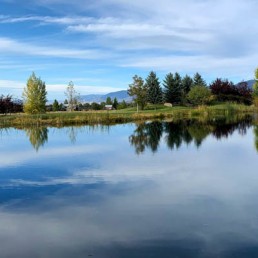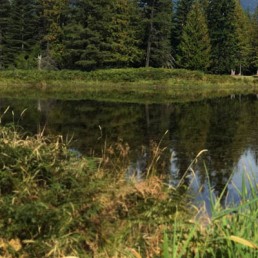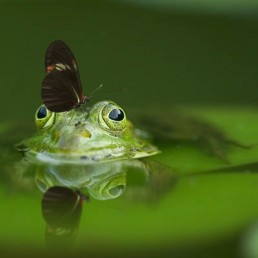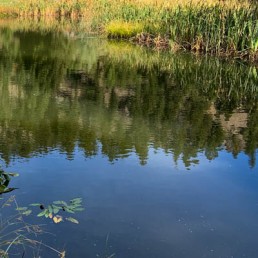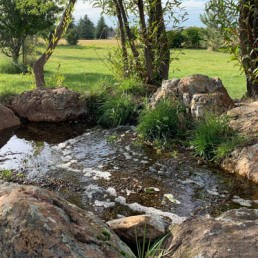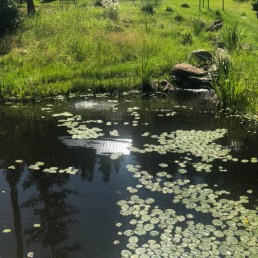Montana Pond’s FAQs
The following are frequently asked questions regarding how we tackle pond design, construction, repair and maintenance in Montana.
You should have plants and fish in your pond! A healthy backyard pond and its surroundings create a unique mini environment. Fish and plants are important in maintaining the natural balance. You’ll have a huge selection of beautiful, hardy water plants to choose from. Your pond can be a happy home for decorative fish, native fish and even turtles! Fish are also quite desirable for another reason—they eat mosquito larvae. (Of course, if you like mosquitoes …)
Less than you think! A sturdy plastic liner keeps pond water from seeping into the ground. Water for waterfalls is pumped directly from the pond. A certain amount of water loss due to evaporation is inevitable. This typically amounts to a decrease in water level of a few inches a month during the summer. Shady ponds lose less water than sunny ponds. Windy conditions and shallow, turbulent, splashy streams and waterfalls increase this evaporation rate.
The best way to control algae is to prevent it with appropriate application of beneficial bacteria, aeration and a balance of aquatic plants. However, sometimes algaecides are necessary and Montana Pond’s staff can help you select safe and effective products.
We construct nearly all of our ponds to circulate through a “bog.” We select the plants in the bog specifically for their natural ability to filter suspended particulates and waste byproducts (ammonia and nitrite). So, often a filter isn’t necessary. However, if you want to have a lot of fish, your pond will need a filter. A filter will also be necessary if you want the water to be perfectly clear.
The answer is a definite “maybe.” Depending on your location and the pond design details, you may need a well permit or a building permit. Also, Montana Fish, Wildlife, and Parks requires a permit to stock a pond with native fish.
SPRING You’ll want to check your water feature for any leaks or changes that occurred during the winter. Remove any debris that may have landed in the water around filters or pump areas. You can drain about three-quarters of the pond volume if the water looks like it needs it without disrupting too much of the established ecosystem. If you have early algal blooms, move water plants closer to the edges to encourage their growth and to compete with the algae for nutrients. If you have to use algaecides, keep in mind that they will slow plant growth as well. You can begin feeding the fish when they become active. Turn on pumps and aeration and add any water plants at this time. This also is a good time to add barley extract, beneficial bacteria, and enzymes to your pond system to start protecting the ecosystem you established the year before.
SUMMER Continue with the recommended addition of barley, bacteria, and enzymes. These help keep the pond water clear. If you’re using algaecides, be consistent and follow the manufacturer’s recommendations. You’ll need to know the volume of your pond as most recommendations for pond treatment are volume-based. A rough formula we use is length x width x average depth x 7.5 = # gallons of water. If algae growth becomes a huge problem and impacts the clarity of your water, you may need to add additional aeration. This can be done with fountains, pumps, or aerators, or by adding a stream or waterfall to an existing water feature. Plants are instrumental in promoting water health as well. They can filter out debris, absorb nutrients that algae otherwise would consume, and provide shade for fish. Once established, plants are extremely effective in maintaining pond health and decreasing the need for chemical control. Remove dead plant matter and leaves, and avoid spilling mowing clippings into the pond.
FALL Clean up your pond by removing any organic debris. Stop feeding the plants. Before winter sets in, trim back plant life to remove dead stems and leaves. Move water lilies and any potted plants to the deepest part of the pond where they will be ice-free.
WINTER To keep fish healthy, keep an aerator running to keep a hole in the ice where gases can escape.

So, our hats are off to the Montana Ponds team who this year did our phase 2 project — a natural stream bed that is the waterway for our natural spring to keep the fresh water flowing through for all our aquatic friends’ happiness. We are grateful to live in such an amazing place and to have it naturally enhanced by our little shelf lake to enjoy for ours and future generations of people, wildlife and our native and outrageously cool aquatic friends. And our deepest thanks and gratitude for an outstanding job and enjoyable process to Greg and the team at Montana Ponds. Hmmm, what water project shall we do next?

Elizabeth

